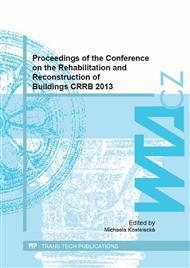p.142
p.149
p.153
p.161
p.165
p.174
p.183
p.187
p.191
Introduction to Problems of Candle Combustion in Buildings
Abstract:
From the earliest times of human history are used portable light sources. First advanced devices were torches and candles, and then human population started using kerosene lamps and other more sophisticated portable light sources based on biology or electricity. Light source based on a chemical reaction has one common denominator and that is the release of fumes while fuel combustion. In these cases, it is the source of its own, which is referred to such bodies or substances in which structure is formed light. Nowadays, historically valuable buildings more often server different purpose than they were originally built. This change in use can lead to a significant influence on historical building and its life span. One of the many factors negatively affecting the life of monuments are fumes from candle combustion. Massive use of candles releases toxic substances into the environment, which in high concentrations can affect human health and can also damage due to chemical reactions historically valuable monuments
Info:
Periodical:
Pages:
165-173
Citation:
Online since:
April 2014
Authors:
Keywords:
Price:
Сopyright:
© 2014 Trans Tech Publications Ltd. All Rights Reserved
Share:
Citation:



